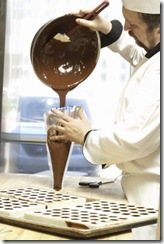This white chocolate truffles recipe is from Ghirardelli's chocolate cookbook. I mentioned this book in my last post when I talked about Domingo Ghirardelli, an Italian who settled in San Francisco and became a successful chocolatier.
I envy people who can make homemade chocolates; next to bread, the smell of chocolates can liven up the atmosphere of any home. Imagine a condo right in the heart of downtown giving off chocolate aromas from the 18th floor! (That might increase the value of your real estate).
The wonderful thing about this recipe is it has only 4 ingredients and the method for making truffles is described in less than 10 sentences!
Here is the recipe for those who want to try their luck with white chocolate truffles (from The Ghirardelli Cookbook, ISBN: 9 781580 088718):
You'll need these ingredients:
* 1/3 cup plus 2 tablespoons heavy cream
* 1 tbsp unsalted butter
* 8 ounces Ghirardelli white chocolate baking bar
* 1 cup shredded coconut or chopped almonds
Procedure:
1. In a small saucepan, bring the cream to a simmer. Add the butter and stir until melted. Add the white chocolate. Stir until completely melted and smooth. Remove from the heat and pour into a shallow bowl.
2. Cool, cover and refrigerate the mixture until firm, at least 2 hours.
3. Using a mellon baller
And voila! That's it - straight from the Ghirardelli company.
Your final batch of chocolate words:
FRENCH | ENGLISH |
| enrobage | enrobing |
| certifié équitable | fair trade certified |
| chocolats fourrés | filled chocolates |
| framboise | raspberry |
| gianduja | gianduja |
| infusion | infusion |
| massepain | marzipan |
| poudre de cacao | cocoa powder |
| graine de cacao décortiquée | cocoa nib |
| mise en moules | panning |
| praline | burnt almond |
| pressurage de la pâte | pressing |
| torréfaction | roasting |
I wasn't sure what gianduja
 What about ganache?
What about ganache?If your supermarket does not sell Ghirardelli chocolates, I don't see why you can't use any other white chocolate. In fact, those white chocolate chips

